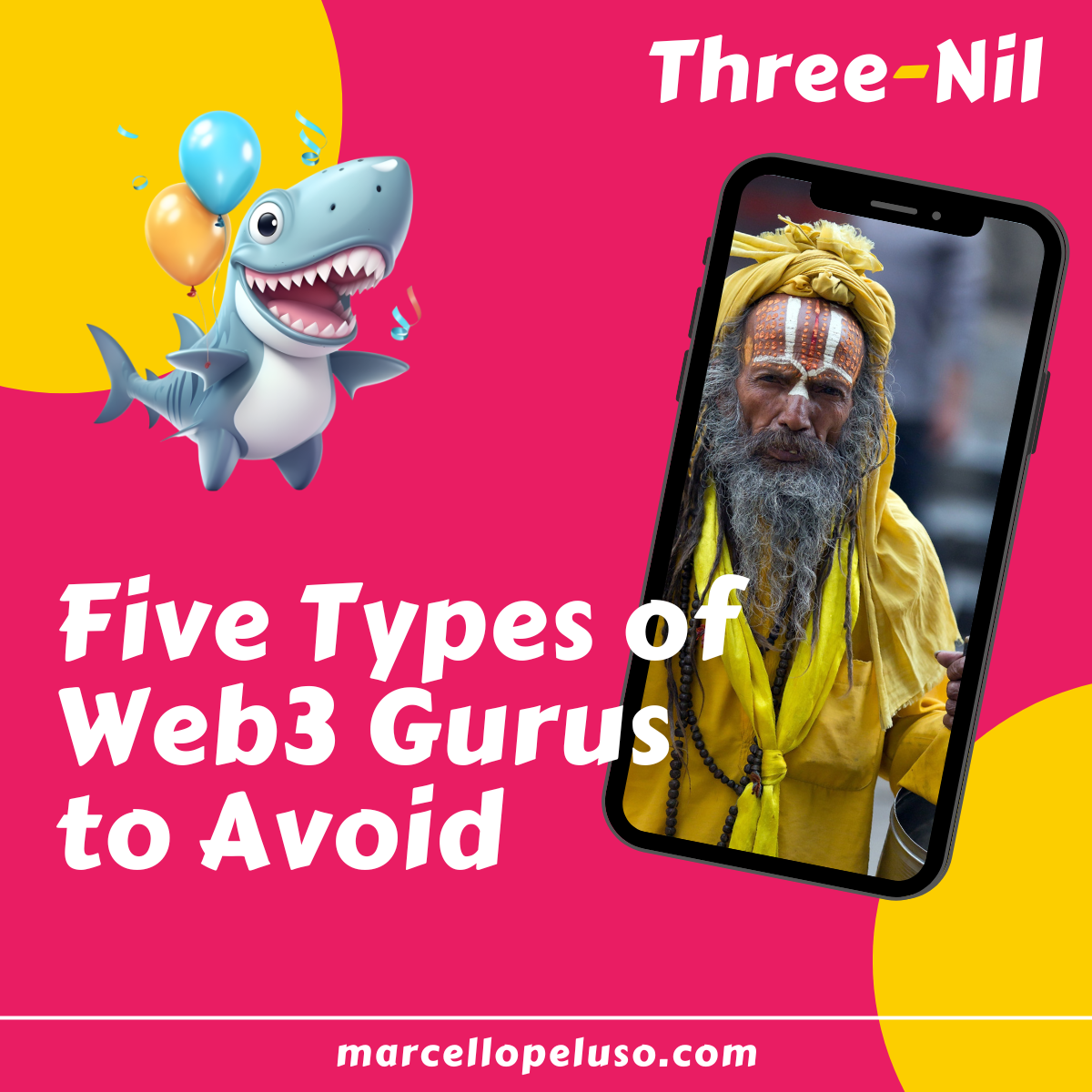
Acquista un prodotto che non esiste ancora: il web3
29/10/2023
Five Types of Web3 Gurus to Steer Clear Of
21/11/2023- X marks the spot
- The differentiating factor of Web 3.0
- Five Types of Web3 Gurus to Steer Clear Of
- Follow the money: from salt to loyalty points
- The future of banks (and our money)
- Password Hunt: are we truly ready to self-regulate when we use the web?
- Let me tell you my secret: I see tokens everywhere
We always talk about Web 3.0, but what sets it apart from Web 1.0 and Web 2.0? Let’s discover it together by exploring the stages of the web.
I still remember the noise of the modem, that infernal device that connected me to the internet in the ’90s. It was a grating sound straight out of Hell, where analog souls entered the purgatory of the web. It promised tears and gnashing of teeth with its slow and unstable connection. Yet, I had known the Commodore 64 well enough to say that the web was going to be a revolution.
Today, I am certain that those who lived through that period, like me, miss it: how happy we were, how carefree life was when there were no social networks, information traveled at the slow pace of print, we made plans using landline phones, and yes… we were young.
That’s it. Seen through the eyes of youth, everything is beautiful. Even my grandfather used to say that, referring to the times of war and resistance!
The bucolic life of Web 1.0

Those of us who washed our laundry in the waves of the internet, where we would one day navigate, were seen as rather eccentric. I saw the first website being created in 1995, and by 1997, I had already created my own. Some thoughts, a photo, an email to be contacted. Yet, no one understood, perhaps not even me, why we were doing it.
We didn’t know it, but that was Web 1.0. No one called it that, or at least no one had warned us that we were at the beginning of a long series of webs. In fact, we could say that no one gave it a proper definition.
I remember that the first article I wrote for the web was titled “Why do I have a website?” My friends made fun of me. Putting a photo on the internet could mean being accused of megalomania, digital extremism, acute narcissism. And why was I doing it? I didn’t have all the answers, but I remember ending the article with a prophetic phrase that now sounds true, “in 10 years, when everyone has one, it will be understood.”
But how did the ancients live in that bucolic society at the dawn of the internet?
We’re in the mid-’90s. I, with long curly hair, created my web page. I did it with difficulty and sweat because the god of the internet had decided so: you shall give birth to websites with pain and only if you know HTML, then you shall write your thoughts on them with tears and sweat on your brow.
No one could easily find you because search engines didn’t exist, or rather, there were long lists called Directories that were a bit like the telephone directory of those times (if you’ve never seen a telephone directory, you’re young, lucky you!). On the other side of the web, you could find my site (more likely, I would have pointed it out to you), and read the content without the possibility of commenting. Then you would have turned off your PC, gone out, stopped at a phone booth, called me, and verbally insulted me for what I had written.
After running out of change, you would have gone to the supermarket for groceries, then to a travel agency to buy a train ticket for the weekend, and finally to an electronics store because you intended to replace your old TV.
The modern age: Web 2.0
Years pass, and the era of social networks, e-commerce, streaming, interaction arrives, and I don’t even realize that I’ve become an adult, immersed in Web 2.0.
In Web 2.0 – a millennium that had already begun some time ago – the same content from the ’90s can be written more easily thanks to WordPress, and then posted on my Facebook page.
You can read my Facebook post, comfortably insult me from your PC through the comment function, then switch to the Supermarket website to shop online, paying with a credit card.
While you add products to your online shopping cart, you can purchase a train ticket on the National Train website using PayPal. As you add the most popular TV models to your “Save for Later” list on Amazon, you can see what other users have voted for.
After your online activities are done, you can now get up from your chair and choose to go out for sports or sit back in your armchair (but I warn you that your doctor won’t agree with the second option, unless you’ve already replaced your family doctor with Google).
In short, Web 2.0 becomes participation. Those who mocked me in the ’90s for posting my photo on the site now proudly display their children’s pictures on Facebook, dance shamelessly on TikTok, or bare it all on Instagram. There is a famous Italian song that says: “You have to know how to choose in time, not get there out of spite: you’re walking around with it all hanging out now, but I was doing it twenty years ago!“
Series 3: Decentralization
And now? Let’s hop in a time machine and zoom into an indefinitely distant future where people live in Web 3.0.
Let’s start with the fact that you might not have PayPal or a credit card (at least not in the forms we know today). What you purchase, you’ll pay for using your virtual wallet where you’ll store your virtual coins (like Bitcoin, Ether, etc., which we’ll call cryptocurrencies).
But I must warn you: in the purists’ concept of Web3, we’ll only have virtual coins because the idea is to eliminate intermediaries like banks.
The distinctive feature of Web3
As we’re here discussing trifles, Twitter becoming X, and the like, I have a déjà vu, like a mid-summer swoon. We’re already in Web 3.0! Well, not really in it, but we see it coming!
According to some experts, it’s the biggest bubble of the century, and according to others, it’s the most exciting future.
So what is the distinctive feature of Web3? One concept seems to emerge prominently: it’s the concept of decentralization, full control of your own data and information without any intermediation. This is likely the key to understanding what Web 3.0 is and will be, distinguishing it from everything else, as a corollary, or what we’re already using and living in Web 2.0.
A strong promise that, from a user’s perspective, can excite those who value privacy or prefer a web with fewer dominant players.
But from a business perspective, the ecosystem in which you operate may be disrupted. How will the next generation of e-commerce work? And the new platforms? What coins will people use for payment? How do decentralized social networks function? How will advertising work in the new world? Can I make users co-owners of my products?
(If you have more questions, let’s share them too.)
What we’ve learned:
- From the early ’90s to today, the internet has evolved significantly.
- At least three periods of the internet are identified: Web 1.0, Web 2.0 (the current era), Web 3.0.
- There isn’t yet a clear, unanimous definition for Web 3.0, but the concept of decentralization will likely be crucial.
